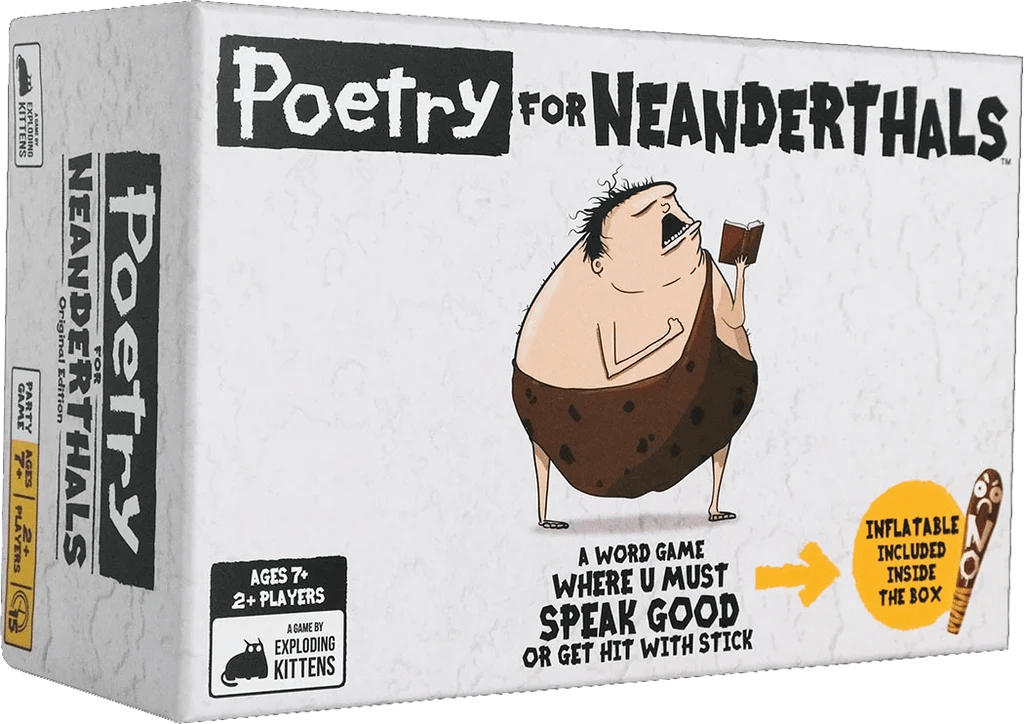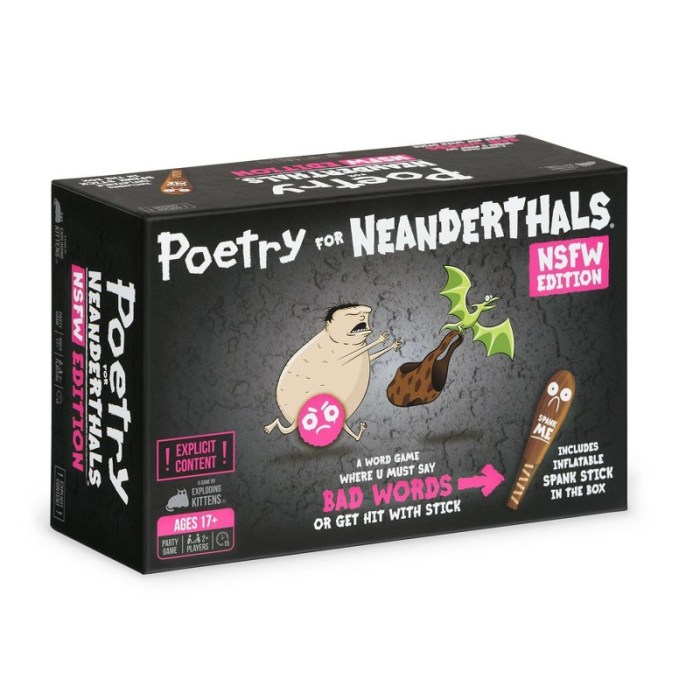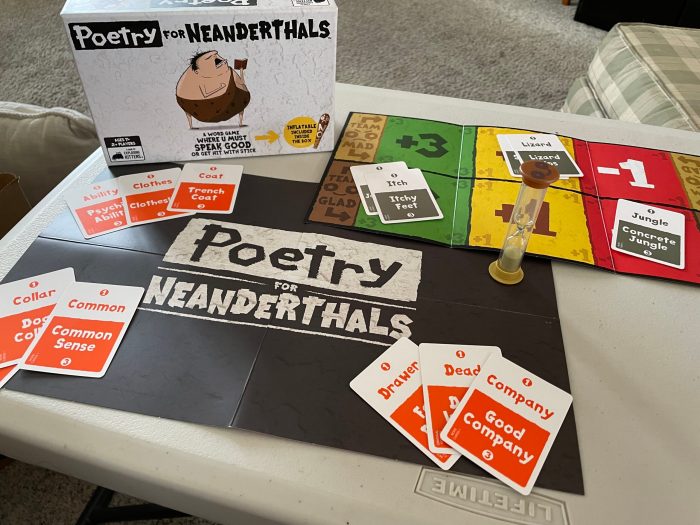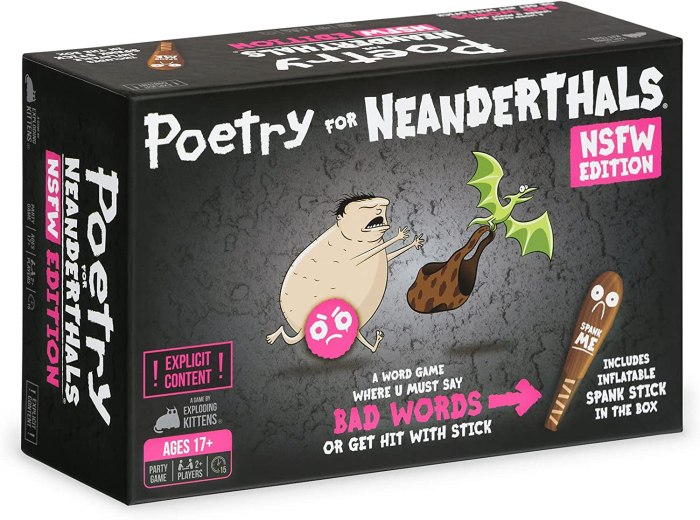Poetry for neanderthals game online – Embark on a captivating journey into the realm of “Poetry for Neanderthals,” an innovative online game that delves into the intriguing possibility of poetic expression among our ancient ancestors. This immersive experience invites players to explore the origins of language, the cultural significance of poetry, and the challenges of interpreting and recreating Neanderthal communication.
Through archaeological discoveries, linguistic analysis, and modern interpretations, the game unravels the enigmatic world of Neanderthals, shedding light on their potential for artistic expression and storytelling. As players navigate the game’s engaging mechanics, they gain insights into the nature of language, the evolution of poetry, and the enduring human connection to creativity.
Historical Context

The Neanderthals were a species of humans who lived in Europe and parts of Asia from approximately 400,000 to 40,000 years ago. They were closely related to modern humans, and some evidence suggests that the two species may have interbred.
There is no direct evidence that Neanderthals practiced poetry, but there are a number of reasons to believe that they may have. First, Neanderthals had a complex language, and they were capable of symbolic thought. Second, they lived in social groups, and they had a rich culture that included art, music, and dance.
Third, poetry is a form of communication that can be used to express emotions, tell stories, and pass on knowledge. It is therefore plausible that Neanderthals may have used poetry as a way to communicate with each other.
Possible Forms of Neanderthal Poetry
If Neanderthals did practice poetry, it is likely that their poems would have been very different from modern poetry. They would probably have been shorter, and they would have used a simpler language. They may also have been more focused on practical matters, such as hunting and gathering.
Some possible forms of Neanderthal poetry include:
- Songs:Neanderthals may have sung songs to accompany their dances or to tell stories.
- Chants:Neanderthals may have used chants to invoke spirits or to heal the sick.
- Riddles:Neanderthals may have used riddles to test each other’s intelligence or to pass the time.
- Proverbs:Neanderthals may have used proverbs to pass on wisdom and knowledge to their children.
Archaeological Evidence
The examination of Neanderthal artifacts offers valuable insights into their cognitive abilities and cultural practices. Among the discovered artifacts, cave paintings, engravings, and other objects provide compelling evidence of symbolic expression and storytelling, hinting at the presence of poetic activities within Neanderthal communities.
Cave Paintings and Engravings, Poetry for neanderthals game online
Neanderthal cave paintings and engravings have been discovered in various regions, including the Iberian Peninsula, France, and Croatia. These artworks often depict animals, hunting scenes, and human figures. While their exact meanings remain subject to interpretation, they demonstrate a sophisticated understanding of representation and a capacity for symbolic communication.
The use of pigments and the intricate details in these artworks suggest that Neanderthals possessed a refined artistic sensibility and an ability to convey complex ideas through visual means.
Other Artifacts
Beyond cave art, other artifacts have also shed light on Neanderthal symbolic expression. Perforated shells and animal bones, for instance, have been interpreted as possible musical instruments or ornaments. These objects indicate that Neanderthals may have engaged in music and other performative activities, which could have played a role in social bonding and cultural rituals.
Linguistic Analysis

The linguistic capabilities of Neanderthals have been a subject of ongoing debate. While they lacked the complex language structures found in modern humans, evidence suggests they possessed a form of communication that may have included elements of poetry.
Vocal Capabilities
Neanderthals had a vocal tract that differed from modern humans, which may have limited their ability to produce a wide range of sounds. However, they possessed a hyoid bone, which is essential for speech production, and their vocal cords were similar to ours.
Studies of Neanderthal skulls have shown that they had a well-developed Broca’s area, a region of the brain associated with language production. This suggests that they may have had the capacity for complex vocal communication.
Symbolic Communication
Neanderthals used symbolic communication, as evidenced by their use of cave paintings, engravings, and artifacts. These symbols may have represented objects, ideas, or emotions, and they may have served as a form of storytelling or communication.
While the exact meaning of these symbols is unknown, they suggest that Neanderthals had the ability to think abstractly and communicate complex ideas.
Influence on Poetry
The limited vocal capabilities and symbolic communication of Neanderthals may have influenced the development of their poetry. Their poetry may have been more focused on rhythm and imagery, with less emphasis on complex language structures.
Additionally, their use of symbols may have allowed them to convey complex ideas and emotions in a concise and evocative manner.
Modern Interpretations: Poetry For Neanderthals Game Online
Contemporary attempts to recreate or interpret Neanderthal poetry reflect a growing interest in understanding the cognitive and expressive capabilities of our hominin ancestors. Despite the lack of direct evidence, scholars have employed various methods to approximate the form and content of Neanderthal poetic expressions.
One approach involves analyzing the linguistic and cultural similarities between Neanderthals and modern humans. By studying the structure and patterns of languages spoken by contemporary hunter-gatherer societies, researchers can infer potential characteristics of Neanderthal communication. This method assumes a degree of cognitive continuity between Neanderthals and modern humans, allowing for inferences about their artistic and poetic traditions.
Translating and Adapting Neanderthal Expressions
Translating or adapting Neanderthal expressions into modern forms poses significant challenges. The absence of written records and the limited understanding of Neanderthal language hinder direct translation. Nevertheless, scholars have attempted to bridge this gap through various methods:
- Linguistic Reconstruction:Researchers use comparative linguistics to reconstruct the possible vocabulary and grammar of Neanderthal languages based on similarities with modern languages.
- Ethnographic Analogy:By studying the oral traditions of present-day hunter-gatherer societies, scholars can draw parallels with Neanderthal cultural practices, including their use of language for artistic expression.
- Artistic Interpretation:Artists and poets have employed their creative imaginations to envision and interpret Neanderthal poetry based on archaeological evidence and linguistic reconstructions.
Cultural Significance

Poetry for Neanderthals likely held profound cultural significance, playing a vital role in their social interactions, rituals, and belief systems.
Poetry served as a means of expressing emotions, sharing knowledge, and preserving cultural traditions. It provided a way for Neanderthals to connect with each other on a deeper level, fostering a sense of community and belonging.
Social Interactions
Poetry facilitated social interactions by providing a platform for communication and storytelling. It allowed Neanderthals to share their experiences, values, and beliefs, strengthening social bonds.
- Poetry facilitated the transmission of knowledge and skills from one generation to another, ensuring the continuity of cultural practices.
- It provided a means of entertainment and recreation, bringing joy and laughter to Neanderthal communities.
Rituals
Poetry was an integral part of Neanderthal rituals, serving as a sacred and powerful tool. It invoked the supernatural, facilitated communication with spirits, and marked important life events.
- Poetry was used in rituals to honor ancestors, celebrate successful hunts, and mark the transition from childhood to adulthood.
- It played a role in healing ceremonies, with specific poems recited to invoke the spirits of healing and restore balance.
Belief Systems
Poetry expressed Neanderthals’ beliefs about the world, their place in it, and the nature of the supernatural. It provided a framework for understanding the cosmos and their relationship with it.
- Poetry conveyed creation myths, explaining the origins of the world and the role of Neanderthals within it.
- It provided a way for Neanderthals to express their fears and hopes, offering solace and a sense of meaning in a challenging world.
Online Game Design
The online game “Poetry for Neanderthals” is an innovative and educational experience that immerses players in the world of Neanderthal poetry. The game’s objectives are to compose and perform poems that reflect the unique style and themes of Neanderthal verse.
Players can explore a virtual environment inspired by Neanderthal cave paintings and artifacts, and interact with other players to share their creations.
The game’s mechanics are designed to encourage creativity and collaboration. Players can use a variety of tools to create their poems, including a library of Neanderthal-inspired words and phrases, and a soundboard of Neanderthal vocalizations. They can also record and share their performances with others, and vote on their favorite poems.
Incorporating Elements of Neanderthal Poetry
The game incorporates several elements of Neanderthal poetry, including:
- Emphasis on rhythm and sound:Neanderthal poetry is characterized by its strong rhythm and use of onomatopoeia, which players can recreate using the game’s soundboard.
- Concrete and evocative language:Neanderthal poems often use concrete imagery and sensory details to create vivid and memorable experiences.
- Themes of nature and survival:Neanderthal poetry often explores themes related to the natural world, hunting, and the challenges of daily life.
By incorporating these elements, the game allows players to experience the unique and expressive qualities of Neanderthal poetry.
Gameplay Analysis

Poetry for Neanderthals offers a unique gameplay experience that simulates the poetic practices of Neanderthals.
The game’s mechanics are designed to reflect the limited vocabulary and expressive range of Neanderthal language, encouraging players to convey complex ideas through evocative imagery and symbolism.
Narrative Structure
The game’s narrative is structured around a series of poetic challenges that players must complete. These challenges range from creating poems about specific themes or events to translating poems from Neanderthal to modern English.
- Each challenge is designed to test the player’s understanding of Neanderthal poetic conventions and their ability to express themselves in a limited language.
- The game provides players with a variety of tools to help them complete the challenges, including a glossary of Neanderthal words and phrases and a rhyming dictionary.
Poetic Mechanics
The game’s poetic mechanics are designed to simulate the way Neanderthals used language to create poetry.
- Players are limited to a vocabulary of around 300 words, which forces them to be creative and resourceful in their use of language.
- The game also includes a number of features that encourage players to use figurative language, such as metaphors and similes.
Immersive Experience
Poetry for Neanderthals is designed to be an immersive experience that transports players back to the Stone Age.
- The game’s graphics and sound effects are designed to create a realistic and atmospheric environment.
- The game also includes a number of educational features that teach players about Neanderthal culture and history.
Educational Value
The game offers a unique educational experience by immersing players in the world of Neanderthals and their culture. Through gameplay, players gain insights into the nature of language, the development of poetry, and the daily lives of Neanderthals.
By interacting with Neanderthal characters, players learn about their beliefs, social structures, and artistic expressions. The game’s interactive format allows players to actively engage with the material, fostering a deeper understanding of Neanderthal culture and history.
Language and Poetry
The game sheds light on the complexities of Neanderthal language and its potential for creative expression. Players encounter different forms of Neanderthal poetry, such as songs, chants, and riddles, and learn about the linguistic structures and poetic devices used by Neanderthals.
Through the analysis of Neanderthal poetry, players develop an appreciation for the cognitive abilities and imaginative capacity of our ancient ancestors. The game encourages players to consider the role of language in human evolution and the development of artistic expression.
Neanderthal Culture
The game provides a comprehensive portrayal of Neanderthal culture, encompassing their daily routines, social interactions, and spiritual beliefs. Players encounter realistic depictions of Neanderthal settlements, hunting techniques, and artistic practices.
By immersing players in the lives of Neanderthals, the game fosters empathy and understanding towards this often misunderstood group. It challenges common misconceptions and presents Neanderthals as complex and capable individuals with a rich cultural heritage.
FAQ Resource
What is the significance of poetry for Neanderthals?
Poetry may have played a vital role in Neanderthal social interactions, rituals, and belief systems, providing a means of expressing emotions, preserving cultural knowledge, and fostering a sense of community.
How does the game simulate Neanderthal poetic practices?
The game incorporates elements of Neanderthal cave paintings, engravings, and other artifacts, allowing players to engage with their symbolic language and explore the potential forms of poetry they may have practiced.
What educational value does the game offer?
The game provides a unique opportunity to learn about Neanderthal culture, the evolution of language, and the nature of poetry. It fosters an appreciation for the diversity of human expression and the enduring power of creativity.
